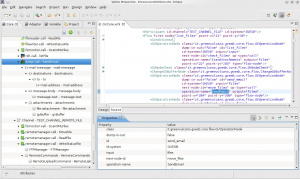Smtp-call
Contents
Description
GreenVulcano® ESB plugin for sending emails.
VulCon / GV Console Configuration
The smtp-call Element is used by Channel, routed-call. Its attributes are:
| Attribute | Type | Description |
|---|---|---|
| type | fixed | This attribute must assume the value call. |
| class | fixed | This attribute must assume the value it.greenvulcano.gvesb.virtual.smtp.SMTPCallOperation. |
| name | required | Operation name. Used in the Flow section to associate workflow nodes to VCL operations. |
| jndi-name | required | JNDI name of the mail Session configured in the application server. |
| override-protocol-host | optional | Corresponds to the property mail.protocol.host and overwrites the value of property mail.host specified in the configuration of the mail Session. |
| override-protocol-user | optional | Corresponds to the property mail.protocol.user and overwrites the value of property mail.user specified in the configuration of the mail Session. |
| message-id-property | optional | Defines the properties that will contain the MessageID of the message sent. Default to MessageID. |
It has the following sub-elements:
mail-message
This element defines the properties of the message. It is used by smtp-call and its attributes are:
| Attribute | Type | Description |
|---|---|---|
| sender-display-name | required | defines the display name of sender. |
| subject | required | The subject of the email. You can enter GVBuffer values using the following syntax:
|
| content-type | required | Email content-type. The attribute's admitted values are:
|
| high-priority | optional | The priority of the mail. The attribute's admitted values are:
|
Its sub-elements are:
destinations
This element contains the list of mail recipients.
Might contain the following sub-elements:
- Description
- to: Contains the list of recipients of the email. Is overwritten by the value of the GVBuffer property GV_SMTP_TO.
- cc: Contains the list of recipients in knowledge of the mail. Is overwritten by the value of the GVBuffer property GV_SMTP_CC.
- bcc: Contains the list of recipients in hidden knowledge of the mail. Is overwritten by the value of the GVBuffer property GV_SMTP_BCC.
Every sub-element (to, cc and bcc) has the sub-elements:
- Description
- mail-address: containing the email address of a recipient. The address value is setted in its attribute:
- address
message-body
The sub-element message-body defines the message body of the email. It is used by mail-message.
It has the following attributes:
- gvBuffer-dump: If true, the GVBuffer dump will be included in the message body. Default: false.
The attribute's admitted values are:- false
- true
It has as sub-elements:
message-text
This element contains the message of the email. You can enter gvBuffer values using the following syntax:
- for standard fields
- ${system}
- ${service}
- ${id}
- ${object}
- ${retCode}
- for properties
- ${property['nome']}
For example, if "object" is a dom can write: ${@it.greenvulcano.util.xml.XMLUtils@serializeDOM_S(object)}
Its attribute escape-HTML-in-gvBuffer-fields allows you to specify whether, when replacing the placeholders for the fields of GVBuffer, any invalid characters for XML/HTML should be replaced with the corresponding entity. Default to true.
attachments
Use this mail-message subelements to define the list of attachments of the email. It is overwritten by the value of the GVBuffer property GV_SMTP_ATTACHMENTS.
It has the following attributes:
file-attachment
Use this element to define the file to attach to the email.
It has the attribute path where you can set the path of the file to attach. The attribute's value can't be null.
gvBuffer
Use this element if you want to attach at the email the GVBuffer contents.
It has the attribute name with which you can define a name of the attachment containing the GVBuffer contents. The attribute's value can't be null.
How To
For inserting a smtp-cal using VulCon® you must right click the element Channel where you are configuring your Flow plugins. Then Insert after (or Insert before) and select smtp-call from the expanded list.
Then you can add a mail-message element where you can set, using more sub-elements, the destinations, the message body and the attachments if required.
The following picture shows a smtp-call element named SendEmail already configured:
The Service EmailFileAttachment which use this plugins must be set as:
<Service group-name="DEFAULT_GRP" id-service="EmailFileAttachment" service-activation="on" statistics="off">
<Operation name="RequestReply" operation-activation="on" out-check-type="sys-svc-id" type="operation">
<Participant id-channel="TEST_CHANNEL_FILE" id-system="GVESB"/>
<Flow first-node="list_files" point-x="21" point-y="38">
<Conditions/>
<GVOperationNode class="it.greenvulcano.gvesb.core.flow.GVOperationNode" .../>
<GVNodeCheck class="it.greenvulcano.gvesb.core.flow.GVNodeCheck" ...>
<GVRouting condition="FilesFound" next-node-id="prepare"/>
</GVNodeCheck>
<ChangeGVBufferNode class="it.greenvulcano.gvesb.core.flow.ChangeGVBufferNode"
dump-in-out="true" id="prepare" input="files" next-node-id="send_email"
op-type="change GVBuffer" output="files" point-x="225" point-y="302" type="flow-node">
<ChangeGVBuffer clear-data="false">
<OGNLScript>property['GV_SMTP_ATTACHMENTS'] =
property['GVFM_FOUND_FILES_LIST']</OGNLScript>
</ChangeGVBuffer>
</ChangeGVBufferNode>
<GVOperationNode class="it.greenvulcano.gvesb.core.flow.GVOperationNode"
dump-in-out="false" id="send_email"
id-system="GVESB" input="files"
next-node-id="move_files" op-type="call"
operation-name="SendEmail" output="files"
point-x="384" point-y="309" type="flow-node"/>
....
<GVEndNode class="it.greenvulcano.gvesb.core.flow.GVEndNode" .../>
</Flow>
</Operation>
</Service>
